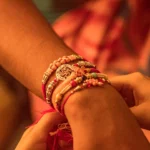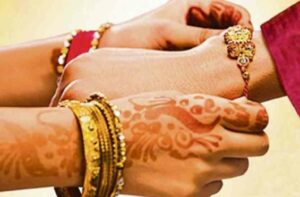
The festival known as Raksha Bandhan (Rakṣābandhanam) falls on the full moon day Śrāvaṇa Pūrṇimā of the Sanskrit month of Śrāvaṇa which normally comes in August.
The word “raksha” means to protect and the word “bandhan” means a bond or tie. The whole ritual centers on the tying of a cotton thread round the wrist of a person. This thread is known as a “raakhi”. The original esoteric meaning of this important custom has been forgotten and now you find many types of fancy bracelets are being used as “raakhis” which have not been consecrated with mantras.

The Sanatana Dharma is the only culture that has placed such a premium and importance on a simple thing like the tying of a thread. At one time India was known for the production of the best organic cotton threads in the world. These threads were used both for the weaving of cotton cloth which was famous all over the world but they were also used for spiritual purposes. A thread is known as a “sutra” in Sanskrit. It means that which binds things together.
The Indian culture made use of many types of substances like, copper, silver, mercury, gold etc in order to transmit energy to others or to the environment. A thread was the simplest of all things that was capable of transmitting energy if it had been dipped in some turmeric powder and energized with mantras. If the appropriate mantras, suitable to the occasion were chanted over the threads they were found to be able to keep these positive vibrations for a long time. In fact, if properly made they could retain the energy for a whole mandala of forty-two to forty-four days. Hence, we are advised not to take off these consecrated threads for this amount of time. Even then we should not cut them with a sharp instrument but take out the knot carefully or burn it slightly so as to take it out. This thread has then to be put round a bush or tree or thrown into flowing water like a river or stream.
When you go to a temple especially temples to the goddess, you will find threads wound round and round the peepul trees growing in the temple compound. These denote the various vows made by the devotees which were tied round the tree and gave positive responses. Threads are also used in various other ways.
The most important of these threads is the “yajnopaveetam” or the thread worn by all Brahmins across their shoulder. This is given at the time of the initiation of a young boy into the sacred Vedas and to the Gayatri Mantra. Actually, there is a lot of esoteric meaning behind the tying of this sacred thread. The string tied round Brahmin children is a pledge made by them to continue with their practice of the ancient dharma or moral values of their culture. It binds them to a life- time of practicing the values of harmony and peaceful coexistence. It is something they wear to help them to remember that they are now born into a new life. They have to remember the fact that they have a deep bond with the divine and the responsibility to keep up the sacred traditions of their culture and pass it on to the new generation. This bond is revived every year by taking on a new sacred thread which is ceremonially put by the priest across their right shoulder. This ceremony should not be taken lightly as a ritual of not much consequence but as a sacred covenant made with God to live a life of purity. It is actually a promise to live in accordance with the laws of nature and to help purify the elements as well as those who live on this earth made up of the elements. In South India Brahmins change their sacred thread on Raksha Bhandan day.
In most rituals it is considered auspicious to have a copper or silver pot with Ganga water to be kept at the side. In South India these pots are totally covered with an intricate design of threads criss-crossed and tied by the priest. This is a special technique and is supposed to denote the complex nature of the “nadis” or nerves in the human being. The “mangal sutra” is a yellow thread tied by the groom round the bride’s neck at the time of marriage. A golden symbol was also put on the thread that had been dipped in turmeric and over which mantras had been chanted by the priest before the ceremony. This again denoted the solemn covenant made by the husband to look after his wife. A married lady always wore it round her neck.
In olden days when people were suffering from some depression or disease, they did not go straight to the doctor as is done now but they went to the temple priest and asked him to make a special thread for them which he would tie round the wrist to the accompaniment of certain mantras. This was called an “abhaya sutra” or string to ward off fear. The tying of a thread which has been blessed by a priest or great soul has a great significance in Hinduism. The priest would bless the thread using mantras and tie it round the wrist of the devotee who needed protection from evil forces. Black threads are tied round a baby’s wrist or waist to keep off evil eyes.
At the beginning of a fire ceremony or even a puja or ritual, the priest will tie a consecrated red thread round the wrists of the people who are taking part in the ceremony. This is called a “kankana sutram”. By this the devotee pledges his devotion to the deity and the deity in turn protects the devotee from all harm. As mentioned earlier this should not be taken out for one full mandala (41 days).
With the passage of time this has become a day to promote fraternal love between siblings especially brothers and sisters. Sisters tie the raakhi round the right wrist of their brothers, who promise to protect them at all times. The sisters in turn pray for the well-being of their brothers. Girls even tie raakhis round the wrists of their boy-friends but the rule is that one can never marry the person on whose wrist you have tied a raakhi since he has automatically become your brother. The raksha bandhan ceremony as is performed in most houses is symbolic of the everlasting bond between brothers and sisters even though they may live in different continents and oceans may separate them.
This particular day has been popularised by the great poet Rabindranth Tagore to promote a feeling of unity and commitment to all the members of the society and includes a solemn promise to protect each other in times of calamity. Actually, this consecrated thread can be tied round the wrist of anyone who needs protection not necessarily a brother. In olden days wives used to tie talismans on a thread blessed by the priest, round the wrist of their husbands before they set out for war. In the Mahabharata war you find that all the great heroes had this thread tied on them before they set out for the battle every day. The symbolic act of tying this thread protects your loved one from all dangers. In fact, you are actually putting an armour of protection round them. Draupadi is supposed to have tied it round Krishna, Sachi, the wife of Indra is supposed to have tied it round Indra’s wrist when he went to fight with the asura Vritra and Lakshmi round the wrist of Mahabali etc.
The most popular mantra that is to be chanted while tying the string is this
“Yena badho Baliraja, danavendra Mahabala,
Tena twaam abhibhadnaami raksha ma chala, ma chala.”
“May this thread that protected the mighty asura king Mahabali, protect you always.”
On the morning of Raksha Bandhan day one should prepare oneself both physically and mentally. One should take a bath and sit in meditation for a while and make a vow to observe a life of purity in thought, word and deed. Thus, the main aspect of Raksha Bandhan is the surrender of one’s own self to God for He is indeed the true brother whose strong arm alone will protect you from all harm at all times.
This fact has been totally forgotten by most people in these times. The raksha is meant to be a protection for the person on whom it is tied. It has been potentised with the power of the mantra and the turmeric powder that it has been dipped in and when it is tied with faith by mother or wife or sister or priest, it forms a bond between the divine and the person on whom it is tied and surely it will protect them from all harm. This is the attitude by which we should tie it and receive it.